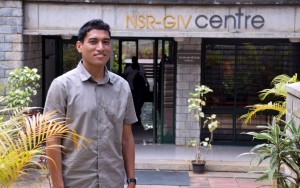Friends, critics and business partners — this father-son duo who run a 145-year old jewellery house get candid about their relationship in and out of office
As a class four student when Chaitanya V Cotha was diagnosed with dyslexia, his father, C Vinod Hayagriv, the Managing Director of C Krishniah Chetty & Sons (CKC), felt like there was a wall in front of him. “What was the future going to be like, where would this lead to, what would he be, will he be himself, would it be a difficult life?” Hayagriv recalls asking himself. Referring to his elder son as a Taare Zameen Par kid, he adds, “Initially, we felt terrible as parents. It just wasn’t easy.”
But, today, when he looks back, Hayagriv is a proud father. Full of praise about how Cotha not only overcame his disability but also went on to manage the 1869 founded family-run business as its Executive Director, the 54-year-old also points out how Cotha has spearheaded three ventures of his own. When we meet the father-son duo at The Touchstone, off Cubbon Road on Friday morning, Hayagriv says, “He’s got a fighting determination. Most people would have given up midway.”
Which is the reason Hayagriv would be present at every parent-teacher meeting to make note of his son’s progress. “That’s something I didn’t do for my younger son,” he says, even as father and son unanimously agree that Shreyas is the “smartest” in the family. Talking about how Cotha has trained himself well in the last 10 years — from not being able to read long passages to pursuing a course in gemology and an MBA course, we are told that he is called back to school (Mallya Aditi International School) to talk to students facing similar issues.
When Hayagriv entered the family-run business in the ’80s, it was considered a natural progression for him to join his father CV Hayagriv (known as Hayagriv senior). But it was a different story when Cotha, who completed his Masters in Business Management from Regis University in 2009, was to enter the business in 2010.
Although the idea of joining the family business was always at the “back of his mind”, Cotha had begun applying for jobs back in the US.
He even got an offer from a leading jewellery brand in the world, which incidentally was also a family business. Wanting his father to aid in the decision-making process, Cotha asked his dad to come over and take a look at the place he might be working at. Never mind the speeding ticket that they got while driving down from San Diego to Arizona (which Cotha admits was his fault), Hayagriv laughs as he tells us that he was impressed with the line-up of Rolls-Royce and Porches in front of the store. “It’s a fine life that he gave up. If I were him, I might still take that option,” Hayagriv says. To which Cotha immediately reminds him that he was recently offered a position to head the store in California.
“It was completely his decision. We had a couple of brainstorming sessions with my sisters, one in Mysore, and the other in the US, to give their suggestions,” Hayagriv says. To which Cotha says, “But, right at the beginning my father had set things straight; I remember him saying, ‘The business is not built for you.’ That way he’s very open in how he thinks, he never forced us to come back.”
Starting from scratch
When Cotha finally took the decision of coming back to India, he didn’t join his father as one would have expected. Instead, he started a new business of his own —1869 Guild, a manufacturing and wholesale jewellery business. Having taken no financial assistance from his father, Cotha, who was working out of an office space on Avenue Road, found himself going to small jewellers in Karnataka, Tamil Nadu and Andhra Pradesh, Punjab to get dealers for his venture. And within a span of 18 months, he had tied up with 250 stores.
Going from jeweller to jeweller, “without being the shadow of his father” was tough, he admits. But, looking back, he is thankful for the experience of spreading the word about the set-up and learning the ropes of the business. “When you go out there, people don’t know who you are. I was out travelling to smaller places in the state, at least 20 days a month. I must admit, it was hard, but I enjoyed it. People looked at me as me — not part of CKC,” he says.
It was a similar story when Cotha’s younger brother, Shreyas was contemplating his plan of action after graduation. But, following his elder brother’s example, Shreyas too ditched the offer to work for the “second largest jewellery company” in the world to join the CKC in 2012.
Work and play
When it comes to working with his sons, Hayagriv makes no bones when he admits that it’s “very tough”. A generation gap, different mindsets and conflicting viewpoints are some of the reasons for this. “When I was working with my father, it was different. I used to do as he said. But with my sons it’s different. They are opinionated, there are numerous debates, and all this requires a lot of tolerance. But, in a way, it is positive,” says Hayagriv, who consults his father even today when it comes to taking decisions. “But whatever happens, we never walk out of arguments,” Cotha adds.
For instance, at present, they are working on a wealth and asset management structure that would work for each of the four families (Hayagriv senior, junior, the two sons and their families). Hayagriv and his father are planning a safety net (in terms of old age, health) for each of the family members. “My father has done a lot of family settlements and partitions in his life. These are the areas that his experience comes in handy,” he says.
When it comes to their working styles too, they’re like chalk and cheese. Though Hayagriv thinks about work 24/7, with dinner table conversations revolving around the business, Cotha switches off once he’s out of office. “No screen time post work hours. I must credit that to my wife Yagnika,” says Cotha, who spends his free time with his toddler son.
When Hayagriv does unwind, he often heads outdoors — golfing or trekking. In fact, earlier this year, Hayagriv used a Trikke to commute to work. “Actually, Dad is a fun guy off work,” Cotha reveals. As a principle though, the family, we’re told, never goes on vacations together. It’s planned in such a way that one of them is there to ensure the business runs smoothly.
The women in their lives
Behind these successful men, are their wives, who they credit for keeping them going through ups and downs. Hayagriv turns to his wife Triveni for financial advice, although he doesn’t heed it all the time. “Especially in stock market matters, there are times that she has told me that I should just sell them but I didn’t,” he says, regretting the I-told-you-so moments this gives rise to.
Although Cotha turns to his father for advice on business, he’s also influenced by his mother, who is involved in charity work. “She cares a lot for people in general. Those are some qualities I hope to inherit,” he adds. Looks like this is one family with ties as solid as gold.
source: http://www.bangaloremirror.com / BangaloreMirror.com / Home> Columns> Sunday Read / by Vidya Iyengar, Bangalore Mirror Bureau / December 21st, 2014








